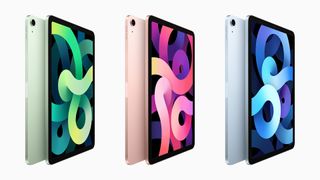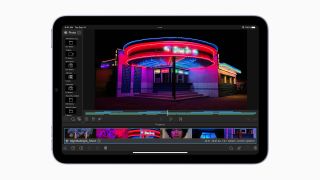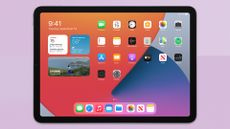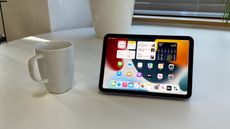This iPad mini vs iPad Air guide aims to help make all the differences between these two tablet clear, because there's a lot that's very similar, but plenty that's different.
The arrival of the iPad mini (2021) answers a question we’ve been puzzling over for some years now. What is the iPad mini actually for? What started off as a cheaper, smaller iPad became a smaller, more expensive iPad, and in recent years it’s often lagged behind the rest of the rest of the range for updates.
Not any more. The iPad mini (2021) is a significant improvement that costs less than the iPad Air (2020) and in some areas outperforms it. But the iPad Air remains an extremely tempting option in itself, thanks to its larger screen
Let’s discover the differences between two of the hottest tablets out now – and don't forget that we also have our full iPad models compared list, plus our best iPad deals guide.
iPad mini (2021) vs iPad Air (2020): price and release date
The iPad Air was released in October 2020, while the iPad mini is released on 24 September 2021.
The iPad mini starts at $499/£479/AU$749 for 64GB and $649/£619/AU$979 for 256GB. Cellular models cost $150/£140/AU$230 more.
The iPad Air is $599/£579/AU$899 for 64GB and $749/£729/AU$1,129 for 256GB. Cellular models are $130/£130/AU$200 more.
• Pre-order iPad mini at Apple US
• Pre-order iPad mini at Apple UK
• Pre-order iPad mini at Apple Australia

Three of the iPad Air's most fetching colours.
Pad mini (2021) vs iPad Air (2020): design and display
These are both colourful computers: the iPad Air comes in silver, space gray, rose gold, green and sky blue, while the new iPad mini is available in space gray, pink, purple and starlight, a kind of beige gold.
The iPad mini is 195.4 by 134.8mm and 6.3mm high and weighs 293g (297g for cellular models), while the iPad Air is 247.6mm by 178.5mm and 6.1mm high. It’s 458g for the Wi-Fi model and 460g for the Wi-Fi+Cellular version. Both kinds of iPad have the Touch ID fingerprint sensor integrated into the sleep/wake button up top.
The mini has a bigger screen than before. It’s an 8.3-inch IPS display delivering 2266x1488 pixels at 326ppi with P3 colour gamut support, Apple's True Tone tech to make it more comfortable to view in the evenings, and 500 nits of brightness.
That’s all very similar to the larger screen in the iPad Air: it’s 10.9 inches, with a resolution of 2360x1640 at 264ppi, so the iPad mini's screen is actually sharper. The Air also offers True Tone, P3 support and 500 nits of brightness.
Both of these devices are designed to work with the second generation Apple Pencil, which connects magnetically to the side and charges wirelessly. Both machines have 60Hz screens, rather than the 120Hz ProMotion screens you find in the iPad Pro (2021)
They both have dual microphones and stereo speakers, too.

The iPad mini is powerful enough for advanced video editing.
iPad mini (2021) vs iPad Air (2020): processor and storage
Both kinds of iPad come in a choice of two storage capacities: 64GB and 256GB. These will be sufficient for home use, though it's a shame there isn't a 512GB option for people who want to use them for drawing or photography, and might end up with lots of files.
However, while they might share storage options, their processors differ. The iPad Air has the A14 Bionic chip, also seen in the iPhone 12, while the new iPad mini has the new A15 Bionic, as seen in the iPhone 13. Specifically, it has the version with a five-core GPU, as seen in the iPhone 13 Pro.
Apple hasn't really talked about the performance improvement we should should expect when jumping from A14 to A15, so we look forward to testing that ourselves, when we can.
Both devices run iPadOS 15, with all the latest and greatest features – there's no difference in capabilities.

The iPad Air's camera is pretty capable.
iPad mini (2021) vs iPad Air (2020): cameras
Both iPads have a 12MP wide-angle camera on the rear with f/1.8 aperture. The mini has a quad-LED True Tone flash and both iPads have Smart HDR 3 processing. For video, both iPads can do 4K at up to 60fps and slo-mo at 120fps or 240fps.
The FaceTime camera on the front is better in the iPad mini, where it’s a 12MP Ultra Wide with f/2.4, time-lapse video with stabilisation and lens correction. The selfie shooter in the iPad Air is 7MP with f/2.2. Both cameras can record at up to 60fps 1080p Full HD, but only the iPad mini includes Apple's Centre Stage feature, which automatically adjusts the camera to follow your movement in video calls.
iPad mini (2021) vs iPad Air (2020): battery, charging and connectivity
Both iPads come with a 20W USB-C charger and cable, but the battery is, as you’d expect, smaller in the mini: it’s a 19.3-watt-hour battery compared to the iPad Air’s 28.6-watt-hour battery. Nevertheless battery life is a quoted 10 hours for both iPads.
Wi-Fi here is 802.11ax, aka Wi-Fi 6, and both iPads also have Bluetooth 5.0. The cellular version of the iPad Air is 4G LTE but the cellular edition of the new iPad mini is 5G.
iPad mini (2021) vs iPad Air (2020): conclusion
Apple seems to fall in and out of love with the iPad mini and often leaves it languishing while it updates the other iPads, but the 2021 model is very impressive. For $100/£100/AU$150 less than the excellent iPad Air you’re getting a better processor, a better selfie camera and a sharper screen.
We think the deciding factor here is what you’re going to be doing on your iPad and where you’re going to be using it. The difference between screen sizes isn’t dramatic, but if like us you spend a great deal of time reading magazines in Apple News+ or Readly on the sofa, you’ll perhaps agree with us that going lower than the 10.9 inches of the iPad Air’s display is not something you’d want to do.
But maybe the lighter weight of the iPad mini is preferable for reading long books, or if you take it with you out of the home a lot for work – and the 5G connectivity won't hurt there, either. It's also lighter on the wallet, of course, despite being faster than the Air, and with a sharper screen.
With the updated iPad mini we think the iPad range is more clearly differentiated than before. There’s the most affordable, entry level iPad, which is a great device for families, for education, for entertainment and for general sitting-around-doing-apps stuff. There’s the Air, which delivers extra oomph for more demanding users. There’s the iPad Pros for creative types who need extra horsepower, bigger displays and specialist high-end features.
And the iPad mini is back to doing what it’s best at: delivering iPad Air-style power for gaming and creative uses, but with extra portability.










